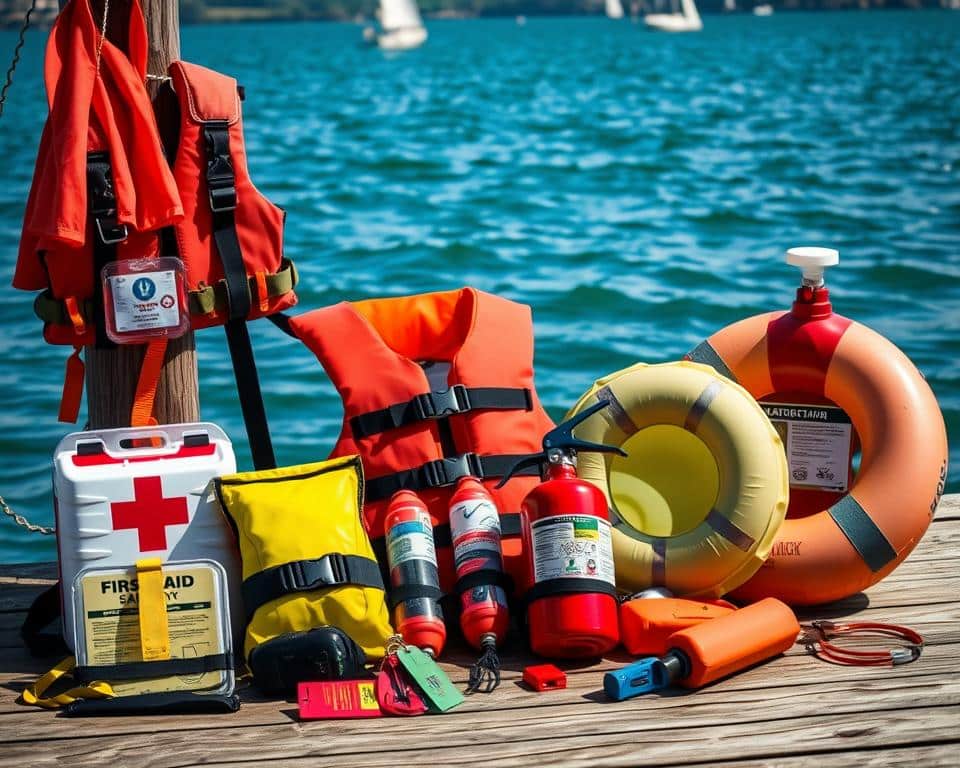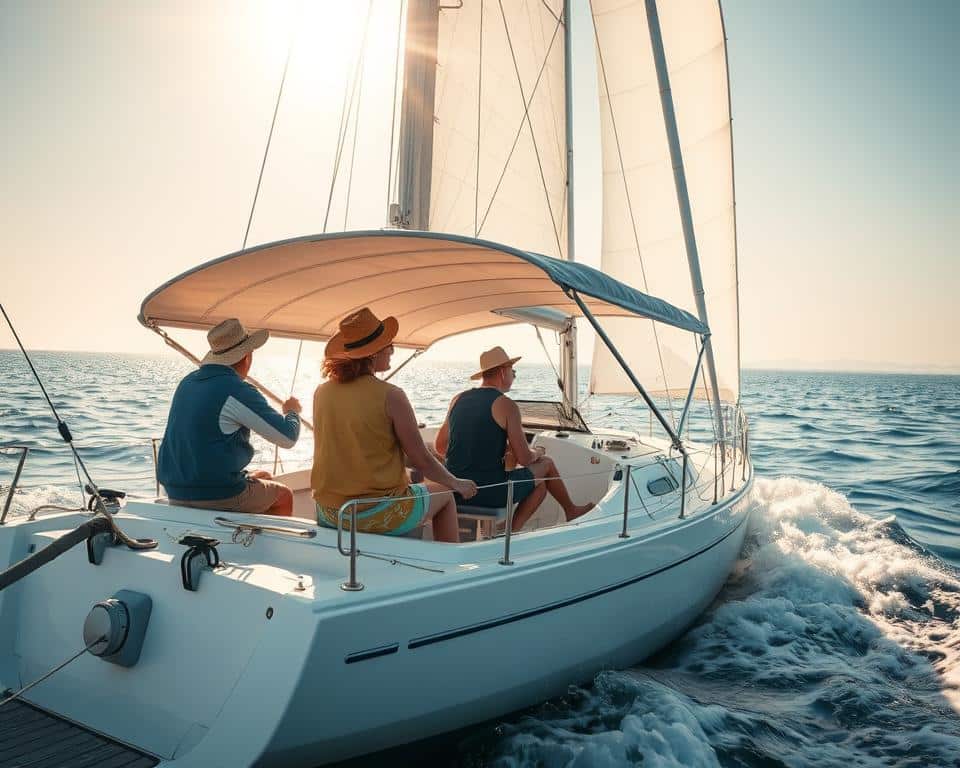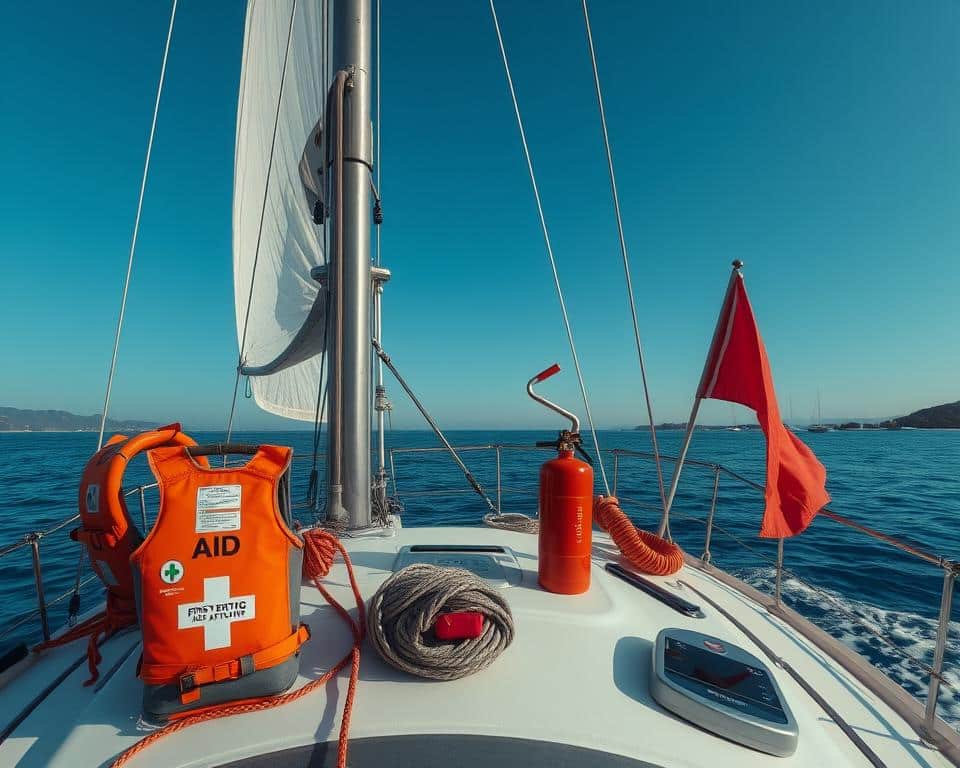I’ve learned to love the peace and freedom of the open sea as a sailor. But ensuring safety is key to enjoying a day on the water. It’s vital to follow boating safety rules to protect everyone onboard.
Before we sail, it’s important to focus on safe boating. By following safety rules, we cut down the risk of accidents. For example, in 2022, the U.S. saw 4,040 boat incidents. This is much less than the 6 million car accidents each year. It shows why we must stick to safety tips during the summer.
Being a responsible boater means understanding the risks and preparing. Check the weather, know your boat, and have safety gear ready. Following local boating laws also helps keep us safe. Using advanced safety technologies makes us even more prepared.
I aim to keep my passengers safe by sticking to safety rules. This helps prevent problems and keeps the boat safe.
Importance of Sailing Safety
Boating is a fun activity, but keeping everyone safe is key. It’s crucial to ensure safety while sailing. This includes making sure life jackets are used and following local water rules. Taking steps to avoid boating accidents can save lives and protect boats.
Protecting Lives on the Water
Drowning is the top cause of death in water incidents, says the CDC. Everyone on a boat should wear a life jacket, no matter how well they swim. Having regular safety drills helps people know what to do in an emergency. Following boating rules, like speed limits, makes things safer. The NASBLA has info on rules about life jackets for different ages.
Being prepared is important. Check things like fuel and battery levels before you leave. Make sure safety equipment is ready and working. Regular checks are important for preventing boat accidents.
Preserving Your Boat
A boat is a big investment and taking care of it is important. Doing regular maintenance keeps your boat in good shape. This includes fixing things like hull cracks and making sure the engine works well. Keeping the boat from being too heavy is also key. It helps prevent capsizing. Using the right safety gear is important for keeping the boat and everyone safe.
Taking a boating safety course is a great idea. The Coast Guard’s app has lots of helpful tips. For more on staying safe while sailing, check out Discover Boating.
Must-Have Boat Safety Equipment
Having the essential boating safety equipment is key to a great time on the water. It’s not just about your safety. It also keeps everyone on the boat safe. Before you sail, check you have all the right safety gear.

Life Jackets
Life jackets are crucial for marine safety. Every boat must have enough life jackets for all passengers, says the U.S. Coast Guard. Although required, many boaters don’t wear them. This reduces their effectiveness. Wearing life jackets is essential, not just having them around.
Fire Extinguishers
A fire extinguisher is vital for onboard safety. Fires can start suddenly. Having a working extinguisher can prevent a disaster. The Coast Guard requires boats to have them. Make sure yours is properly maintained and checked regularly.
Communication Devices
Effective communication devices are critical. Cell phones help, but a VHF radio is essential in emergencies. Yet, few boaters have a backup VHF radio. Registering and testing your EPIRBs and PLBs is also vital. For safety tips, visit the emergency communication guidelines.
Emergency Flares
Emergency flares signal for help and make your boat visible. Keep your flares dry and use them before they expire. Many boaters lack proper signaling gear. This shows the need for better safety awareness and practices.
Regular Boat Maintenance Practices
Making sure my boat is safe and lasts long means following a strict maintenance and safety schedule. Keeping up with maintenance stops unexpected problems and makes sure boating is smooth. Here are the main steps I take to keep my boat ready for the sea.
Check for Mechanical Issues
Looking for mechanical problems regularly is key to stopping issues before they start. This means checking if the propeller is damaged and if everything is tightly secured. I look at fuel and electrical systems to find any wear, leaks, or connection issues. This helps avoid fires and electrical problems.
I also replace anodes before they’re halfway worn out. This keeps the metal parts of my boat from corroding.
Inspect Safety Gear
Before I head out, I check all the safety equipment. I make sure fire extinguishers, emergency flares, and communication tools work well. It’s also important to check that life jackets and distress signals are in good shape. Doing these checks makes me feel much safer on the water.
Keeping up with boat maintenance cuts down costs and makes my boat run better. This is true whether I’m getting it ready to store or just keeping it in good condition. If you’re looking for more tips on keeping your boat safe and efficient, check out this boating guide.
Being Aware of Your Surroundings
I love the peace of sailing, but staying alert is key. Watching out for other boats, swimmers, and dangers is a must. This helps avoid accidents and keeps everyone safe on board.
To prevent accidents, safe boating habits are essential. Reading water and weather, and knowing water rules are critical skills. I always check my boat and safety gear, like life jackets and flares, before going out. This keeps my boat in good shape and prepares me for emergencies.
Did you know 74% of boating deaths in 2022 were where the captain didn’t know boating safety? That’s why learning and training in safety are important. I tell someone I trust about my boating plan and when I’ll come back for extra safety.
To show the value of being alert and safe at sea, here’s a comparison:
| Aspect | Without Awareness | With Awareness |
|---|---|---|
| Accident Risk | High | Low |
| Emergency Preparedness | Poor | Excellent |
| Equipment Reliability | Uncertain | Assured |
| Overall Safety | Compromised | Enhanced |
Avoiding distractions is part of safe boating too. Not using cell phones or blasting music helps me stay focused. And having the right lights for when it’s dark or foggy is crucial to avoid hitting anything.
Following these best methods prevents accidents and ensures a fun, safe trip for everyone. Staying aware and trained makes every sail a great experience.
Alcohol and Boating: A Dangerous Combination
Boating under the influence of alcohol is illegal and very risky. It puts both drivers and passengers in danger. In 2023, alcohol was tied to 17% of boating deaths. Drinking can blur a boater’s judgment, leading to risky choices.
In states like Texas, many factors cause boating accidents. These include not paying attention, not keeping a good lookout, lack of experience, going too fast, and drinking. Stopping drinking while boating is key to staying safe. Alcohol makes it hard to keep balance and react quickly, which are vital on the water.
Drinking while boating has more risks than you might think. It can make you get cold faster by making your blood vessels wider. Also, alcohol can make you more dehydrated. This is worse when it’s hot out, and you’re being active on a boat.
If there’s an emergency on the boat, drunk boaters may not act right. They might make small problems much bigger. Texas treats drunk boating like drunk driving, with fines, losing your license, or jail time. By not drinking and boating, we make the water safer for everyone.
Essential Water Safety Measures
Going boating is really fun. However, being safe is what truly makes the outing enjoyable. Last year, there were 4,040 boating incidents in the U.S. This shows how important it is to know and follow safety rules. I’ll talk about swimming safely in open water, protecting yourself from the sun, and staying hydrated.
Swimming Precautions
Swimming in open waters requires caution. Stay close to the boat and pay attention to currents. This is because even if you’re a good swimmer, open waters can surprise you. It’s also smart to have someone watching swimmers from the boat. This helps lower the chances of accidents.
Sun Protection

Being in the sun too long while sailing can harm your skin. It’s key to use sunscreen with a high SPF every two hours and to wear clothes that shield you from UV rays. UV protection on boats is super important. It safeguards your skin and makes the trip more comfortable.
Staying Hydrated
It’s easy to get dehydrated while boating because of the sun and wind. Always have plenty of water on board. Also, remind everyone to drink water often. Heat and activity can trick you into not noticing you’re thirsty. Drinking water keeps you safe and focused while on the water.
Advanced Safety Technologies in Sailing
New safety tech has made me much more confident in sailing. These advancements improve navigation and emergency responses. This makes every trip safer.
Navigation Systems
Sailing has changed with new tools like Electronic Chart Display and Information Systems (ECDIS) and Automatic Identification Systems (AIS). They offer real-time data and detailed maps for better journey planning. Plus, Dual Station Communication (DSC) radios help us instantly talk to other ships and coastal bases, boosting safety at sea.
Personal Locator Beacons
Devices like Emergency Position Indicating Radio Beacons (EPIRB) and Personal Locator Beacons (PLB) are key for sending out SOS signals. Yachts need to have safety gear on board as the law states, to protect everyone on board. The Bell’s catamaran uses a Garmin In-Reach to let others track it online every 30 minutes. In emergencies, these gadgets are lifesavers, guiding rescue teams to the right spot.
Fire Suppression Systems
Having automated systems and portable extinguishers helps manage fires on yachts. You must have extinguishers in every main area like cabins and outdoor lockers. It’s important for crews to learn about fire safety to react well in crises. Plus, gas alarms warn us about leaks early on. All these tools work together to keep us safe from fires.
If you’re looking for tips on being ready for emergencies, I suggest reading what to use if you’re out of distilled water. It’s filled with useful advice on preparing for emergencies.
Thanks to these new safety features, sailing is more fun and a lot safer. With better ways to navigate, signal for help, and control fires, the sea has become a safer place for everyone.
Conclusion
I’m about to set sail, holding my sailing safety commitment close to heart. Knowing the ropes about safety and having the latest tech brings peace of mind. Every step, from packing life jackets to regular boat checks, aims to cut down risks. I focus on being safe on the water by being proactive and alert.
Looking at boating accident stats shows how crucial being alert and prepared is. In 2022, there were 658 deaths in boating mishaps, many victims not wearing life jackets. Taking a navigation course boosts my safety. An emergency kit on board lowers distress calls by 20%, proving readiness is key.
I understand the need for the latest safety tech and basic water safety. Sailing safely is about respecting the sea and avoiding risks before they happen. Learning about the weather and not drinking while sailing shows my safety pledge. This way, I enjoy sailing fully while keeping everyone safe.

